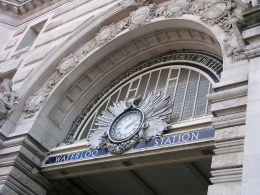Posted 11th February 2011 | 3 Comments
Station use declines, but Waterloo is still on top

NEW figures showing the number of people who use British stations have revealed a modest decline, which probably reflects the effects of the economic downturn.
Nationally, total station usage fell by an average of 0.8 per cent in 2009-2010, but these statistics are older than the general passenger figures, which have started to rise again in the last calendar year.
Although usage fell a little in the year to March 2010, London Waterloo has remained at the top of the table, with 86,397,666 users – a fall of two per cent. London Victoria stayed in second place with 70,224,543 – a slight rise – and London Liverpool Street is still third, with 1,596,155 – a fall of six per cent.
The busiest station outside London was Birmingham New Street, with 25,267,757 – also up slightly on the 2008-2009 total of 25,191,945.
At the other end of the table are the quietest stations. The least-visited station of all on National Rail was Coombe on the Looe branch in Cornwall, with just 42 users throughout the year, although Looe itself had 88,520 users.
By comparison, 42 people use Waterloo every 15 seconds or so, averaged over 24 hours.
The ‘station footfall’ tables are published annually by the Office of Rail Regulation. Although they are based on ticket sales they try to estimate all entrances and exits, rather than just people boarding or alighting from trains.
Larger stations do attract considerable numbers of people who are not travelling, either because they are ‘meeters and greeters’ or intend to use shops and other services.
One often quoted example of ‘non-travelling’ usage is St Pancras International, with just over 18 million users annually, where there has been a deliberate attempt to promote the station as a social and retail centre as well as a travel terminal.
Ben Ruse, from the station’s owner and operator High Speed 1, told Railnews that the commercial model does include visits by non-travellers.
“The model depends on a minimum of 25 per cent of visitors coming to St Pancras to use the facilities there rather than travelling, and in reality the average figure through the year is currently about 30 per cent,” he said.
”But although we never forget that St Pancras is a station first and foremost – and that is its primary role, of course – we always set out to make it part of the community as well, and to make it a place that would be attractive in its own right.”
Reader Comments:
Views expressed in submitted comments are that of the author, and not necessarily shared by Railnews.

Jim Campbell, Solihull
It refers to people who buy tickets.
What if you are on a season ticket or local authority pass.
In the West Midlands we do not pay to use local trains as well as buses so that could push New Street up even higher.
mrmerton, London, UK
The scandal of the disused platforms track and flyover of the old international terminus goes on and on ! Idiotic , costly and shameful. The railway is now too expensive for many people and one canonly wonder what is the value of the Office of Rail Regulation ? perhaps someone could explain what will improve by counting 'footfall' ?
David Garnett, Manchester
Does this also include passengers who change services at a station.
Consider a journey from Manchester to Leicester which involves changing at Sheffield.